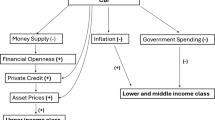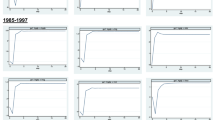Abstract
The high growth performance of a number of South-East Asian countries led to their being baptized ‘miracle growth economies’ by the World Bank. The following paper reviews the theories and stylised facts relating to the sudden reversal in this miraculous growth saga. The reasons for the failure of the first phase of the IMF rescue package are examined and the need for the establishment of a new global financing architecture outlined.
Similar content being viewed by others
References
Cf. World Bank: The East Asian Miracle: Economic Growth and Public Policy, Oxford University Press, New York 1993.
Ibid. Cf. World Bank: The East Asian Miracle: Economic Growth and Public Policy, Oxford University Press, New York 1993.
See R. M. Solow: A Contribution to the Theory of Economic Growth, in: Quarterly Journal of Economics, Vol. 70, 1956, pp. 65–94.
See A. Young: Lessons From the East Asian NICS: A Contrarion View, in: European Economic Review, Vol. 38, 1994, pp. 964–973; also J. Kim and L. J. Lau: The Sources of Economic growth of the East Asian New Industrialised Countries, in: Journal of the Japanese and International Economies, Vol. 8, 1994, pp. 235–271.
P. Krugman: The Myth of Asia's Miracle, in: Foreign Affairs, 1994, Vol. 73, No. 6, pp. 62–78.
R. J. Barro: Economic Growth in a Cross-Section of Countries, in: Quarterly Journal of Economics, 1991, Vol. 106, No. 2, pp. 407–433; D. Romer: The Origins of Endogenous Growth, in: Journal of Economic Perspectives, 1994, Vol. 8, No. 1, pp. 3–22.
M. Dowling and P. H. Summers: Total Factor Productivity and Economic Growth Issues for Asia, in: The Economic Record, 1998, Vol. 74, No. 225, pp. 170–185.
S. Salant and D. Henderson: Market Anticipation of Government Policy and the Price of Gold, in: Journal of Political Economy, Vol. 86, 1978, pp. 627–648; P. Krugman: A Model of Balance of Payments Crises, in: Journal of Money, Credit and Banking, Vol. 11, 1979, No. 3, pp 311–325; R. Flood and P. Garber: Collapsing exchange rate regimes: some linear examples, in: Journal of International Economics, Vol. 17, 1984, pp. 1–13.
M. Obstfeld: Models of Currency Crisis with Self-Fulfilling Features, in: European Economic Review, Vol. 40, 1996, pp. 1037–1047.
F. Kydland and E. Prescott: Rules Rather than Discretion. The Inconsistency of Optimal Plans, in: Journal of Political Economy, Vol. 85, June 1997, pp. 473–491; R. Barro and D. B. Gordon: A Positive Theory of Monetary Policy in a Natural Rate Model, in: Journal of Political Economy, Vol. 91, August 1983, pp. 589–610.
R. Flood and N. Marion: Perspectives on the Recent Currency Crisis Literature, NBER Working Paper, No. 6380, 1998.
S. Radlet and J. Sachs: The East Asian Financial Crisis: Diagnosis, Remedies, Propects, at: http://www.hiid.harvard.edu/ pub, 1998.
D. Diamond and P. Dybvig: Bank Runs, Deposit Insurance, and Liquidity, in: Journal of Political Economy, Vol.91, 1983, pp.401–419.
P. Krugman: What happened to Asia? MIT 1998, mimeo.
Ibid.; Krugman: What happened to Asia?, MIT 1998, mimeo. R. I. McKinnon and H. Pill: Credible Liberalisation and International Capital Flows: The “Overborrowing Syndrome”, in: T. Ito and A. O. Krueger (eds.): Financial Deregulation and Integration in East Asia, National Bureau of Economic Research, East Asia Seminar on Economics, Vol.5, University of Chicago Press 1996.
S. Radelet and J. Sachs, op.cit.: The East Asian Financial Crisis: Diagnosis, P. Krugman: What happened to Asia?, op.cit. MIT 1998, mimeo.; G. Corsetti, P. Pesenti, N. Roubini: What caused the Asian currency and financial crisis?, Asian Crisis Homepage at: http://www.stern.nyu.edu/nroubini/asia/AsiaHome-page.html, 1998.
M. Goldstein and J. Hawkins: The Origin of the Asian Financial Turmoil, in: Research Discussion Paper No. 9805. Economic Research Department, Reserve Bank of Australia, 1998.
C. P. Kindleberger: Maniacs, Panics and Crashes: A History of Financial Crises, Wiley and Sons, New York 1996.
M. Camdessus: Toward a New Financial Architecture for a Globalized World, http://www.imf.org/external/np/speeches/1998/ 050898.htm.
J. Stiglitz: The Role of International Financial Institutions in the Current Global Economy, Address to the Chicago Council of Foreign Relations, The World Bank, 1998, at: http://www.worldbank.org/ html/extdr/extme/jsspo022798.htm.
M. Guitian: The Challenge of Managing Global Capital Flows, in: Finance & Development, Vol. 35, 1998, No. 2.
Author information
Authors and Affiliations
Additional information
Comments on the paper by Dr. Tony Makin and Kyle Bruce of the Dept. of Economics. University of Queensland, are gratefully acknowledge.
Rights and permissions
About this article
Cite this article
Karunaratne, N.D. The Asian miracle and crisis. Intereconomics 34, 19–26 (1999). https://doi.org/10.1007/BF02928968
Issue Date:
DOI: https://doi.org/10.1007/BF02928968




